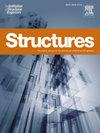利用 BP 神经网络和测量数据预测带波纹钢腹板的 PC 梁桥的温度场
IF 3.9
2区 工程技术
Q1 ENGINEERING, CIVIL
引用次数: 0
摘要
由于混凝土材料与钢材的比热容存在显著差异,在太阳辐射、环境温度和风速的共同作用下,带波纹钢腹板(CSW)的预应力混凝土(PC)梁桥表现出相当大的非均匀温度场。为阐明带波纹钢腹板 PC 梁桥非均匀温度场的分布特征,提高温度场的计算效率,本研究提出了一种基于反向传播(BP)神经网络的结构温度场高效求解方法。本文建立了一个数值模型来模拟带 CSW 的 PC 梁桥的热传导、辐射和对流过程。分析了箱梁结构在太阳辐射强度、空气温度和风速共同影响下的温度场特征,并根据测量数据进行了验证。在此基础上,构建了一个 BP 神经网络代用模型,用于快速准确地求解波形钢腹板 PC 梁桥的温度场。研究结果表明,BP 神经网络结构在复合梁桥钢板和混凝土的预测温度与实际温度之间的误差极小。平均判定系数为 0.9985,表明对混凝土的温度预测优于对钢结构的预测。本文章由计算机程序翻译,如有差异,请以英文原文为准。
Temperature field prediction for a PC beam bridge with corrugated steel webs using BP neural network and measured data
Due to the significant difference in specific heat capacity between concrete materials and steel, the prestressed concrete (PC) beam bridge with corrugated steel webs (CSWs) exhibits considerable non-uniform temperature fields under the combined effects of solar radiation, ambient temperature, and wind speed. To elucidate the distribution characteristics of non-uniform temperature fields in PC beam bridges with CSWs in service and improve the computational efficiency of temperature fields, this study proposes an efficient solution method for structural temperature fields based on the Back Propagation (BP) neural network. In this paper, a numerical model is established to simulate the heat conduction, radiation, and convection processes in PC beam bridges with CSWs. The temperature field characteristics of the box girder structure under the combined influence of solar radiation intensity, air temperature, and wind speed are analyzed and validated against measured data. Based on this, a BP neural network surrogate model is constructed to rapidly and accurately solve the temperature field of corrugated steel web PC girder bridges. The research results indicate that the BP neural network structure exhibits minimal errors between the predicted and actual temperatures of steel plates and concrete in composite girder bridges. The average coefficient of determination is 0.9985, indicating that the temperature prediction for concrete is superior to that for steel structures.
求助全文
通过发布文献求助,成功后即可免费获取论文全文。
去求助
来源期刊

Structures
Engineering-Architecture
CiteScore
5.70
自引率
17.10%
发文量
1187
期刊介绍:
Structures aims to publish internationally-leading research across the full breadth of structural engineering. Papers for Structures are particularly welcome in which high-quality research will benefit from wide readership of academics and practitioners such that not only high citation rates but also tangible industrial-related pathways to impact are achieved.
 求助内容:
求助内容: 应助结果提醒方式:
应助结果提醒方式:


